Page 43 of 72
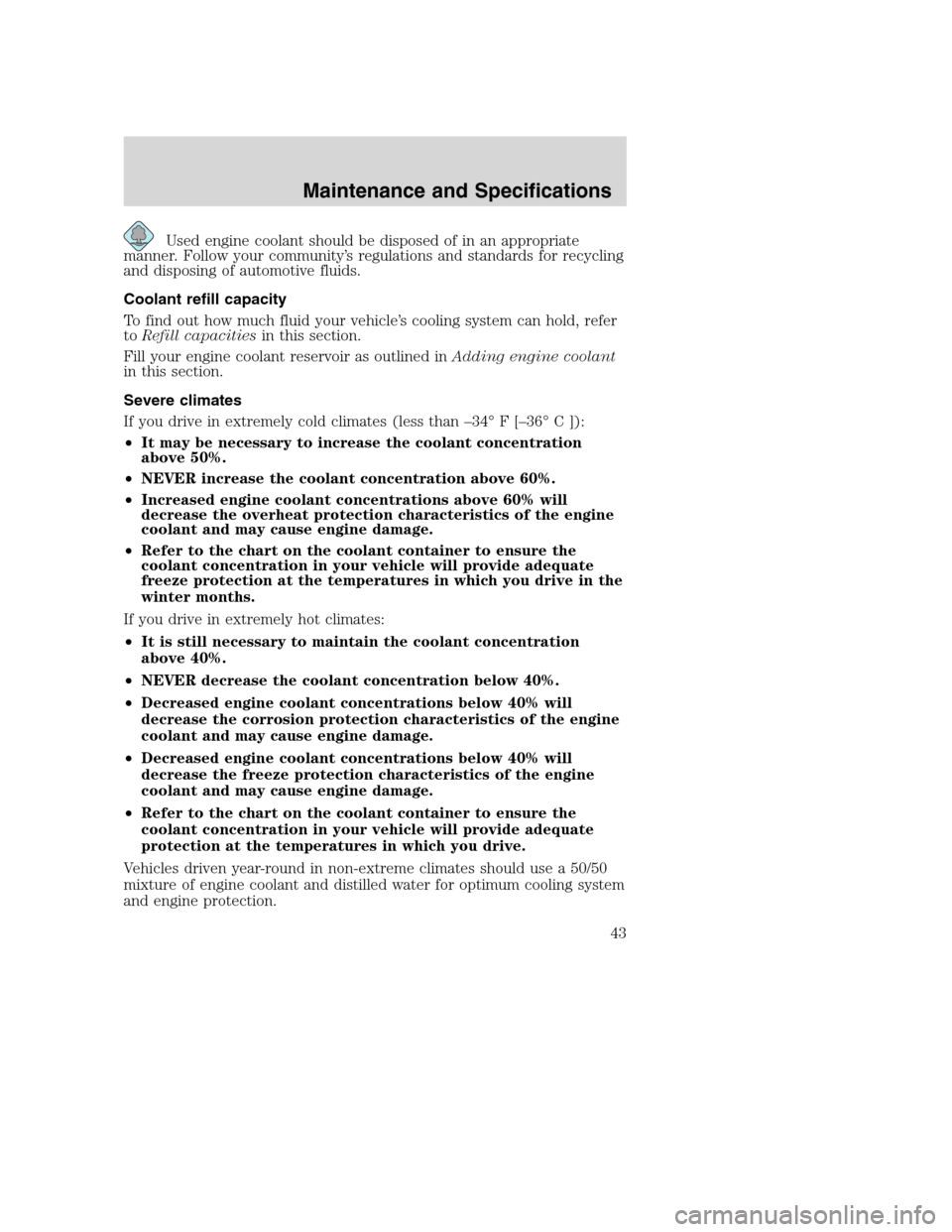
Used engine coolant should be disposed of in an appropriate
manner. Follow your community’s regulations and standards for recycling
and disposing of automotive fluids.
Coolant refill capacity
To find out how much fluid your vehicle’s cooling system can hold, refer
toRefill capacitiesin this section.
Fill your engine coolant reservoir as outlined inAdding engine coolant
in this section.
Severe climates
If you drive in extremely cold climates (less than–34°F[–36°C ]):
•It may be necessary to increase the coolant concentration
above 50%.
•NEVER increase the coolant concentration above 60%.
•Increased engine coolant concentrations above 60% will
decrease the overheat protection characteristics of the engine
coolant and may cause engine damage.
•Refer to the chart on the coolant container to ensure the
coolant concentration in your vehicle will provide adequate
freeze protection at the temperatures in which you drive in the
winter months.
If you drive in extremely hot climates:
•It is still necessary to maintain the coolant concentration
above 40%.
•NEVER decrease the coolant concentration below 40%.
•Decreased engine coolant concentrations below 40% will
decrease the corrosion protection characteristics of the engine
coolant and may cause engine damage.
•Decreased engine coolant concentrations below 40% will
decrease the freeze protection characteristics of the engine
coolant and may cause engine damage.
•Refer to the chart on the coolant container to ensure the
coolant concentration in your vehicle will provide adequate
protection at the temperatures in which you drive.
Vehicles driven year-round in non-extreme climates should use a 50/50
mixture of engine coolant and distilled water for optimum cooling system
and engine protection.
Maintenance and Specifications
43
Page 46 of 72
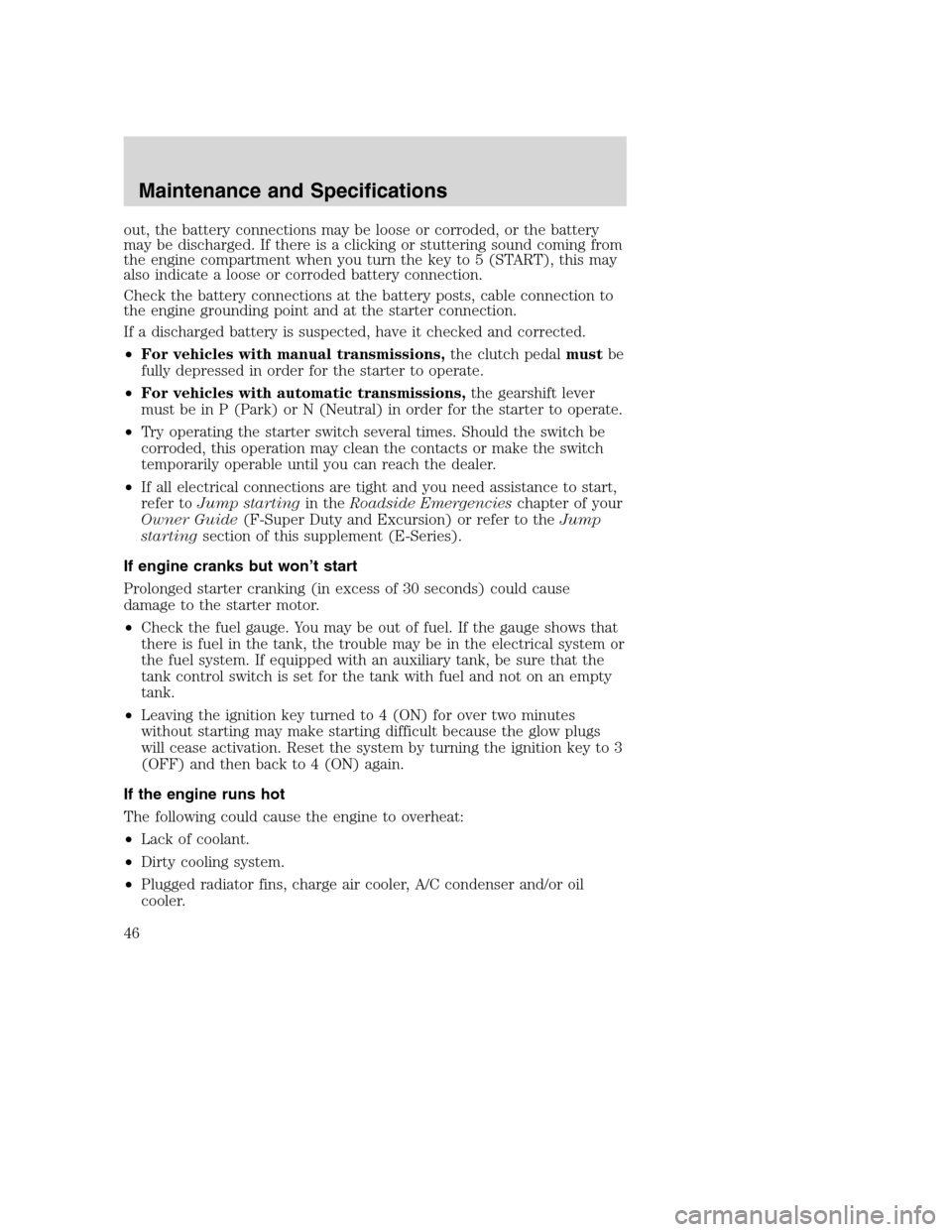
out, the battery connections may be loose or corroded, or the battery
may be discharged. If there is a clicking or stuttering sound coming from
the engine compartment when you turn the key to 5 (START), this may
also indicate a loose or corroded battery connection.
Check the battery connections at the battery posts, cable connection to
the engine grounding point and at the starter connection.
If a discharged battery is suspected, have it checked and corrected.
•For vehicles with manual transmissions,the clutch pedalmustbe
fully depressed in order for the starter to operate.
•For vehicles with automatic transmissions,the gearshift lever
must be in P (Park) or N (Neutral) in order for the starter to operate.
•Try operating the starter switch several times. Should the switch be
corroded, this operation may clean the contacts or make the switch
temporarily operable until you can reach the dealer.
•If all electrical connections are tight and you need assistance to start,
refer toJump startingin theRoadside Emergencieschapter of your
Owner Guide(F-Super Duty and Excursion) or refer to theJump
startingsection of this supplement (E-Series).
If engine cranks but won’t start
Prolonged starter cranking (in excess of 30 seconds) could cause
damage to the starter motor.
•Check the fuel gauge. You may be out of fuel. If the gauge shows that
there is fuel in the tank, the trouble may be in the electrical system or
the fuel system. If equipped with an auxiliary tank, be sure that the
tank control switch is set for the tank with fuel and not on an empty
tank.
•Leaving the ignition key turned to 4 (ON) for over two minutes
without starting may make starting difficult because the glow plugs
will cease activation. Reset the system by turning the ignition key to 3
(OFF) and then back to 4 (ON) again.
If the engine runs hot
The following could cause the engine to overheat:
•Lack of coolant.
•Dirty cooling system.
•Plugged radiator fins, charge air cooler, A/C condenser and/or oil
cooler.
Maintenance and Specifications
46
Page 47 of 72
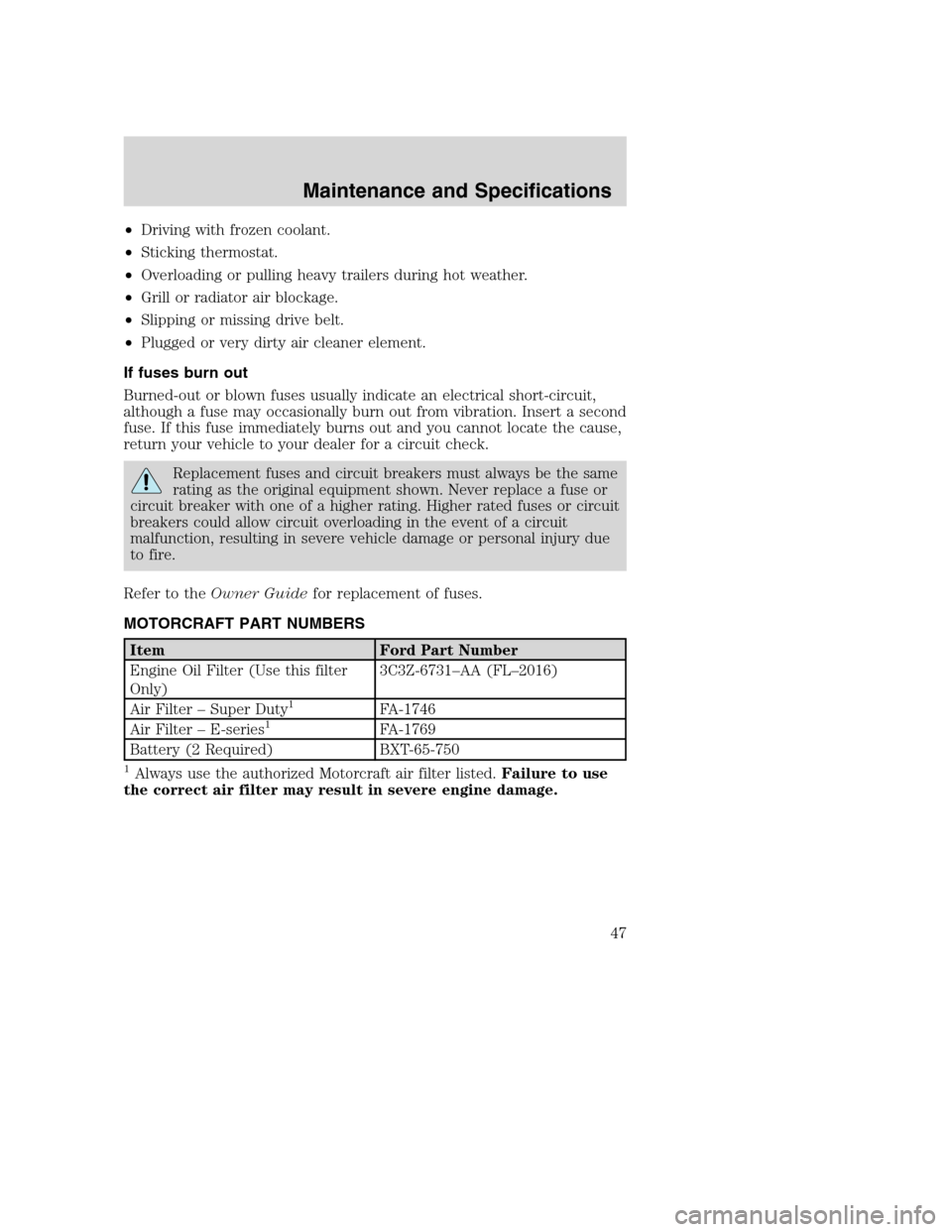
•Driving with frozen coolant.
•Sticking thermostat.
•Overloading or pulling heavy trailers during hot weather.
•Grill or radiator air blockage.
•Slipping or missing drive belt.
•Plugged or very dirty air cleaner element.
If fuses burn out
Burned-out or blown fuses usually indicate an electrical short-circuit,
although a fuse may occasionally burn out from vibration. Insert a second
fuse. If this fuse immediately burns out and you cannot locate the cause,
return your vehicle to your dealer for a circuit check.
Replacement fuses and circuit breakers must always be the same
rating as the original equipment shown. Never replace a fuse or
circuit breaker with one of a higher rating. Higher rated fuses or circuit
breakers could allow circuit overloading in the event of a circuit
malfunction, resulting in severe vehicle damage or personal injury due
to fire.
Refer to theOwner Guidefor replacement of fuses.
MOTORCRAFT PART NUMBERS
Item Ford Part Number
Engine Oil Filter (Use this filter
Only)3C3Z-6731–AA (FL–2016)
Air Filter–Super Duty
1FA-1746
Air Filter–E-series1FA-1769
Battery (2 Required) BXT-65-750
1Always use the authorized Motorcraft air filter listed.Failure to use
the correct air filter may result in severe engine damage.
Maintenance and Specifications
47
Page 48 of 72
REFILL CAPACITIES
Component Capacity
Cooling system127.5 quarts (26.0L)
Engine oil215.0 quarts (14.2L)
Fuel tank (F-250/350/450/550) Refer to yourOwner’s
Guide
Fuel tank (Excursion) 44.0 gallons (166.6L)
Fuel tank (E-Series) Refer to yourOwner’s
Guide
Radiator cap 16 psi (110 kPa)
Manual transmission
35.8 quarts (5.5L)
Automatic transmission Refer to yourOwner’s
Guide
1Includes heater and 5.0 quarts (4.7L) in coolant recovery.
2Includes 1 quart (1.0L) in engine oil filter.
3Use Motorcraft MERCON�ATF, Motorcraft part number XT-2–QDX,
meeting Ford specification MERCON�.
BULB SPECIFICATIONS
Lamp descriptionNumber of bulbs
requiredTrade number
Wait to Start Light 1 194
Water-in-Fuel Light 1 194
Engine Temp. Light 1 194
Maintenance and Specifications
48
Page 49 of 72
LUBRICANT SPECIFICATIONS
ItemFord Part
NameFord Part
NumberFord
Specification
Engine OilMotorcraft
Motor Oil 15W40
Super Duty,
10W30 Super
Duty
1
XO-15W40-QSD,
XO-10W30-QSDWSS-M2C171-D,
CI-4/SL, DHD-1
Engine coolant
Motorcraft
Premium Gold
Engine Coolant
(yellow-colored)VC-7-A (U.S.,
except CA and
OR), VC-7-B
(CA and OR
only)WSS-M97B51–A1
Manual
TransmissionMotorcraft
MERCON�AT FXT-2–QDX MERCON�
Automatic
transmissionRefer to Owner Guide
1Refer to the engine oil specification chart located underEngine oil
specificationsin theMaintenance and Specificationssection of this
supplement.
Maintenance and Specifications
49
Page 53 of 72
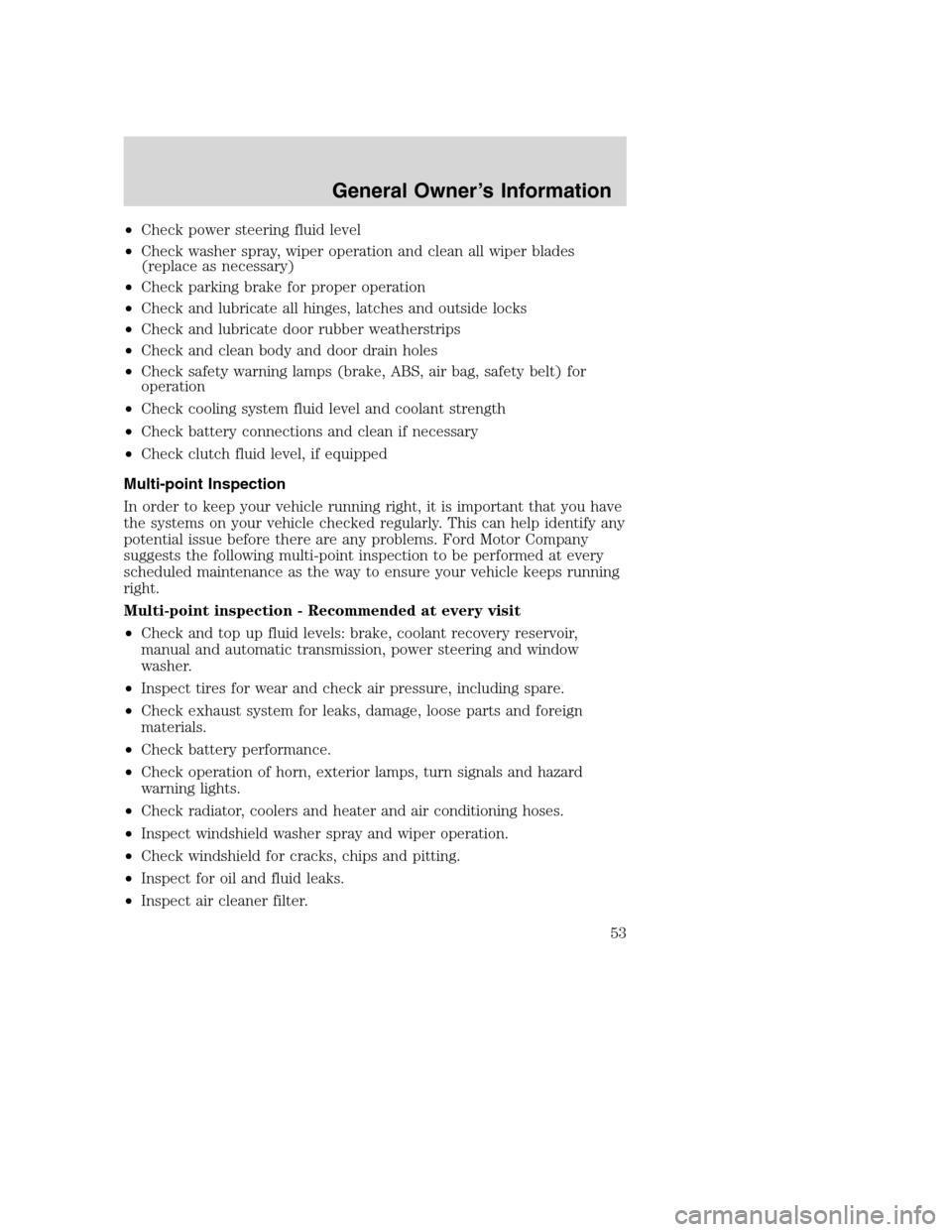
•Check power steering fluid level
•Check washer spray, wiper operation and clean all wiper blades
(replace as necessary)
•Check parking brake for proper operation
•Check and lubricate all hinges, latches and outside locks
•Check and lubricate door rubber weatherstrips
•Check and clean body and door drain holes
•Check safety warning lamps (brake, ABS, air bag, safety belt) for
operation
•Check cooling system fluid level and coolant strength
•Check battery connections and clean if necessary
•Check clutch fluid level, if equipped
Multi-point Inspection
In order to keep your vehicle running right, it is important that you have
the systems on your vehicle checked regularly. This can help identify any
potential issue before there are any problems. Ford Motor Company
suggests the following multi-point inspection to be performed at every
scheduled maintenance as the way to ensure your vehicle keeps running
right.
Multi-point inspection - Recommended at every visit
•Check and top up fluid levels: brake, coolant recovery reservoir,
manual and automatic transmission, power steering and window
washer.
•Inspect tires for wear and check air pressure, including spare.
•Check exhaust system for leaks, damage, loose parts and foreign
materials.
•Check battery performance.
•Check operation of horn, exterior lamps, turn signals and hazard
warning lights.
•Check radiator, coolers and heater and air conditioning hoses.
•Inspect windshield washer spray and wiper operation.
•Check windshield for cracks, chips and pitting.
•Inspect for oil and fluid leaks.
•Inspect air cleaner filter.
General Owner’s Information
53
Page 60 of 72
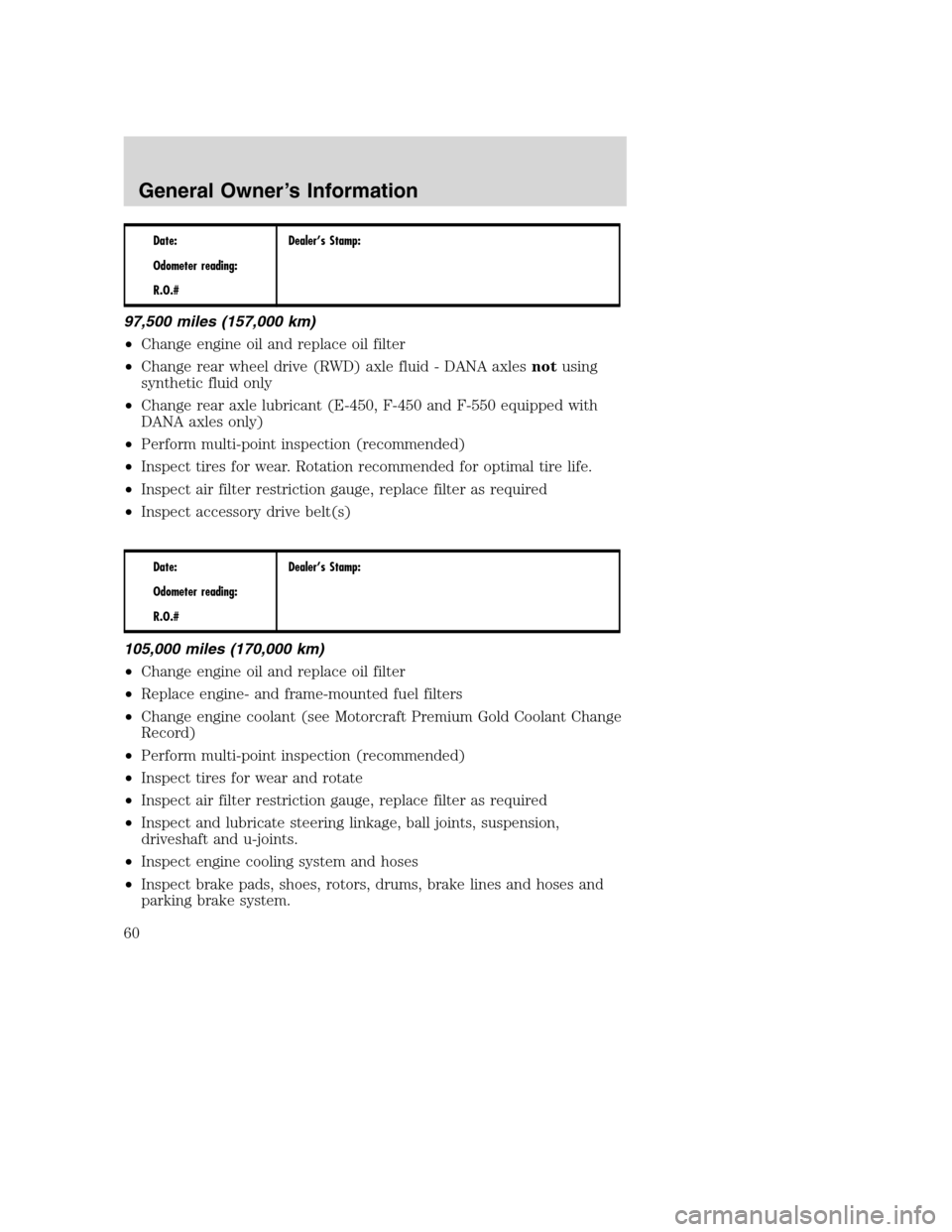
Date:
Odometer reading:
R.O.#Dealer’s Stamp:
97,500 miles (157,000 km)
•Change engine oil and replace oil filter
•Change rear wheel drive (RWD) axle fluid - DANA axlesnotusing
synthetic fluid only
•Change rear axle lubricant (E-450, F-450 and F-550 equipped with
DANA axles only)
•Perform multi-point inspection (recommended)
•Inspect tires for wear. Rotation recommended for optimal tire life.
•Inspect air filter restriction gauge, replace filter as required
•Inspect accessory drive belt(s)
Date:
Odometer reading:
R.O.#Dealer’s Stamp:
105,000 miles (170,000 km)
•Change engine oil and replace oil filter
•Replace engine- and frame-mounted fuel filters
•Change engine coolant (see Motorcraft Premium Gold Coolant Change
Record)
•Perform multi-point inspection (recommended)
•Inspect tires for wear and rotate
•Inspect air filter restriction gauge, replace filter as required
•Inspect and lubricate steering linkage, ball joints, suspension,
driveshaft and u-joints.
•Inspect engine cooling system and hoses
•Inspect brake pads, shoes, rotors, drums, brake lines and hoses and
parking brake system.
General Owner’s Information
60
Page 63 of 72
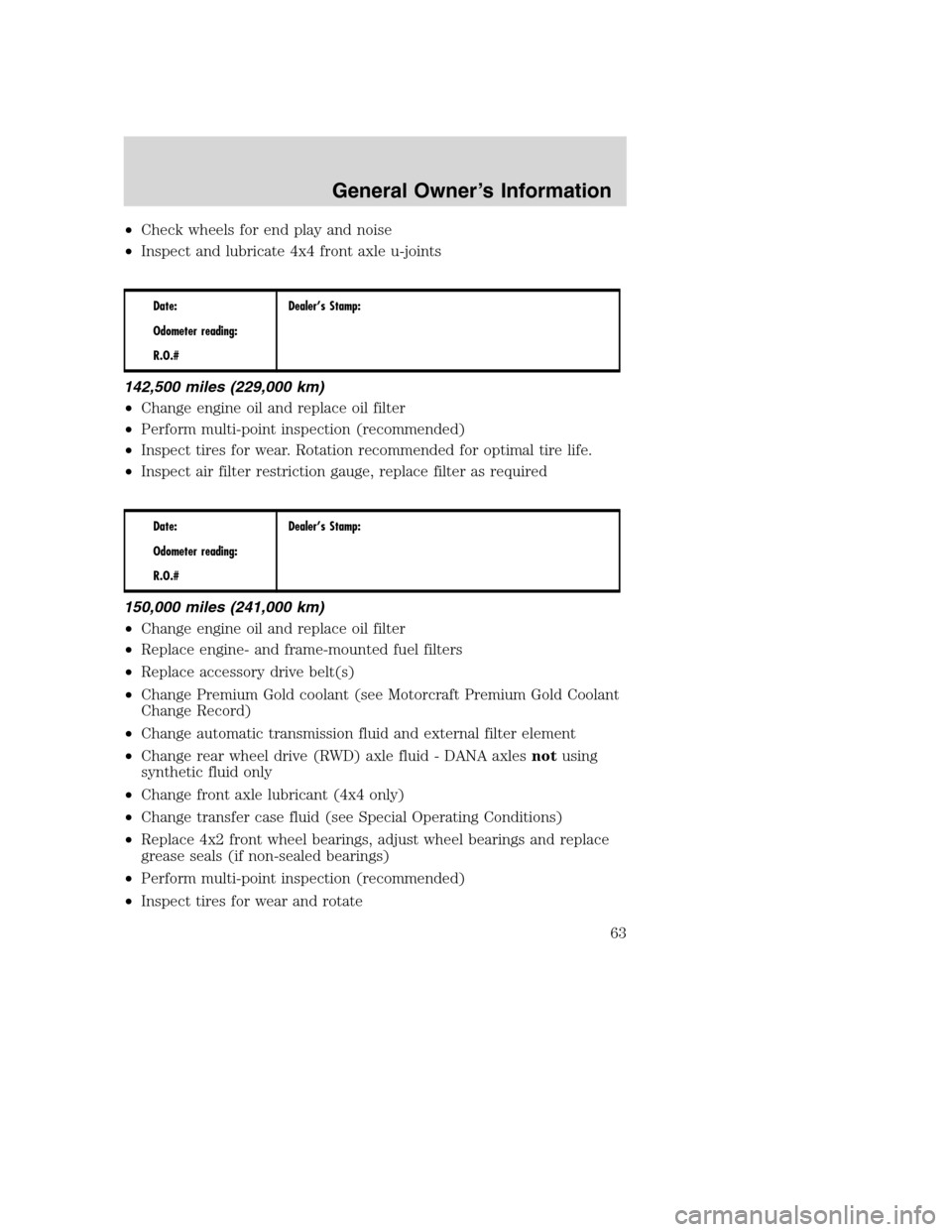
•Check wheels for end play and noise
•Inspect and lubricate 4x4 front axle u-joints
Date:
Odometer reading:
R.O.#Dealer’s Stamp:
142,500 miles (229,000 km)
•Change engine oil and replace oil filter
•Perform multi-point inspection (recommended)
•Inspect tires for wear. Rotation recommended for optimal tire life.
•Inspect air filter restriction gauge, replace filter as required
Date:
Odometer reading:
R.O.#Dealer’s Stamp:
150,000 miles (241,000 km)
•Change engine oil and replace oil filter
•Replace engine- and frame-mounted fuel filters
•Replace accessory drive belt(s)
•Change Premium Gold coolant (see Motorcraft Premium Gold Coolant
Change Record)
•Change automatic transmission fluid and external filter element
•Change rear wheel drive (RWD) axle fluid - DANA axlesnotusing
synthetic fluid only
•Change front axle lubricant (4x4 only)
•Change transfer case fluid (see Special Operating Conditions)
•Replace 4x2 front wheel bearings, adjust wheel bearings and replace
grease seals (if non-sealed bearings)
•Perform multi-point inspection (recommended)
•Inspect tires for wear and rotate
General Owner’s Information
63